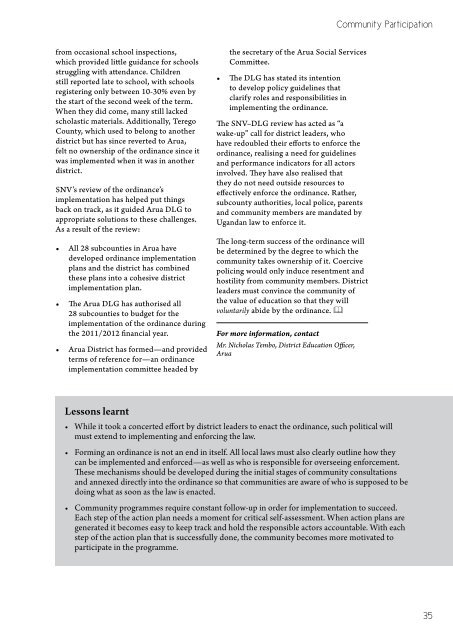School Priorities - SNV
School Priorities - SNV
School Priorities - SNV
Create successful ePaper yourself
Turn your PDF publications into a flip-book with our unique Google optimized e-Paper software.
Community Participation<br />
from occasional school inspections,<br />
which provided little guidance for schools<br />
struggling with attendance. Children<br />
still reported late to school, with schools<br />
registering only between 10-30% even by<br />
the start of the second week of the term.<br />
When they did come, many still lacked<br />
scholastic materials. Additionally, Terego<br />
County, which used to belong to another<br />
district but has since reverted to Arua,<br />
felt no ownership of the ordinance since it<br />
was implemented when it was in another<br />
district.<br />
<strong>SNV</strong>’s review of the ordinance’s<br />
implementation has helped put things<br />
back on track, as it guided Arua DLG to<br />
appropriate solutions to these challenges.<br />
As a result of the review:<br />
• All 28 subcounties in Arua have<br />
developed ordinance implementation<br />
plans and the district has combined<br />
these plans into a cohesive district<br />
implementation plan.<br />
• The Arua DLG has authorised all<br />
28 subcounties to budget for the<br />
implementation of the ordinance during<br />
the 2011/2012 financial year.<br />
• Arua District has formed—and provided<br />
terms of reference for—an ordinance<br />
implementation committee headed by<br />
the secretary of the Arua Social Services<br />
Committee.<br />
• The DLG has stated its intention<br />
to develop policy guidelines that<br />
clarify roles and responsibilities in<br />
implementing the ordinance.<br />
The <strong>SNV</strong>–DLG review has acted as “a<br />
wake-up” call for district leaders, who<br />
have redoubled their efforts to enforce the<br />
ordinance, realising a need for guidelines<br />
and performance indicators for all actors<br />
involved. They have also realised that<br />
they do not need outside resources to<br />
effectively enforce the ordinance. Rather,<br />
subcounty authorities, local police, parents<br />
and community members are mandated by<br />
Ugandan law to enforce it.<br />
The long-term success of the ordinance will<br />
be determined by the degree to which the<br />
community takes ownership of it. Coercive<br />
policing would only induce resentment and<br />
hostility from community members. District<br />
leaders must convince the community of<br />
the value of education so that they will<br />
voluntarily abide by the ordinance. <br />
For more information, contact<br />
Mr. Nicholas Tembo, District Education Officer,<br />
Arua<br />
Lessons learnt<br />
• While it took a concerted effort by district leaders to enact the ordinance, such political will<br />
must extend to implementing and enforcing the law.<br />
• Forming an ordinance is not an end in itself. All local laws must also clearly outline how they<br />
can be implemented and enforced—as well as who is responsible for overseeing enforcement.<br />
These mechanisms should be developed during the initial stages of community consultations<br />
and annexed directly into the ordinance so that communities are aware of who is supposed to be<br />
doing what as soon as the law is enacted.<br />
• Community programmes require constant follow-up in order for implementation to succeed.<br />
Each step of the action plan needs a moment for critical self-assessment. When action plans are<br />
generated it becomes easy to keep track and hold the responsible actors accountable. With each<br />
step of the action plan that is successfully done, the community becomes more motivated to<br />
participate in the programme.<br />
35
















